In this article in our series on the basics of divers’ watches, we take on what is probably the most distinctive element of a dive watch: the rotating bezel.
Its function is actually quite simple: before a diver’s descent, the 12 o’clock bezel marker is aligned with the minute hand, allowing the elapsed time, up to 60 minutes, to be read on the bezel (which is why quite a few dive watches come with a particularly prominent minute hand). A unidirectional, ratcheting construction ensures that – if the bezel is accidentally moved – the time already spent underwater would be indicated as longer than actually spent, providing the diver with a safety reserve for his now more imminent ascent. The bezel/minute hand combination does not, however, directly measure how much air remains in the air tank, as still can be read quite often in press releases.
A standard scuba dive (in which the diver is equipped with a standard air tank) usually lasts 30 to 50 minutes, mostly depending on the depth reached and the shape the diver is in (basically, how physically demanding the dive is). This explains why the first 15 to 20 minutes on the bezel inlay are often more highlighted – the end of this sector theoretically indicates the point of return (exception: “countdown” bezels that mark the time of ascent). In order to correctly time decompression stops at the end of a dive, central-minutes chronographs such as the Aquastar Benthos or even split-minute chronographs, such as the IWC Aquatimer Chronograph from 2004, offer an interesting complication (should the diver not use a computer).
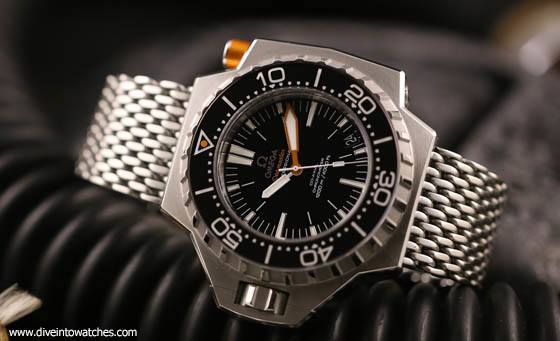
But, back to the start of a dive: In reality, the bezel is aligned when the diver is geared up and ready to begin the dive — which is, most of the time, when he is already in the water or on a boat right before entering the water. It is rarely performed in a dry hotel room, wearing no gloves, when one is able to take off the watch to comfortably set its bezel. So, despite how much I personally love the Omega Ploprof (which features a bi-directional external bezel with a locking mechanism) and the Hublot Oceanographic 4000 (whose unidirectional internal bezel is operated via a screw-down crown which is then placed behind a protective cover), neither are among the easiest watches to be operated single-handedly when worn in the water. And I would strongly advise you never to remove a wet luxury watch from your wrist when there’s a bottomless pit below you.
From a construction point-of-view, there are two main approaches:
1. External bezel
First used for a dive watch by Rolex and Blancpain (inspired by earlier pilots’ watches) in 1953/54, this is still the simplest and most user-friendly approach. Disadvantages include wear from debris,sand or salt getting between the case and the bezel, and the possibility of accidentally moving or damaging the bezel.
As a solution to these issues, Citizen introduced a removable bezel with the Citizen Promaster 1000 in 2002, and IWC launched the Ocean 2000 in 1984, with a bezel that could only be operated counter-clockwise when pushed down (an idea re-introduced in 1998 with its GST Aquatimer). This concept was similarly executed earlier by Certina, with its DS-2 500m in 1968, and later in 2003 by TAG Heuer for the Aquagraph 2000 Chronograph (with a two part bezel) and by Oris in 2009 with the Oris Prodiver (whose bezel needed to be lifted). More or less complicated bezel locking mechanisms — as first introduced on the Omega Ploprof in 1970 and again in its modern version in 2009 — can also be found in the Hublot Subaquaneus, the Squale Tiger, some models from UTS, Germano, and Glycine, and, of course, in older Yema models.
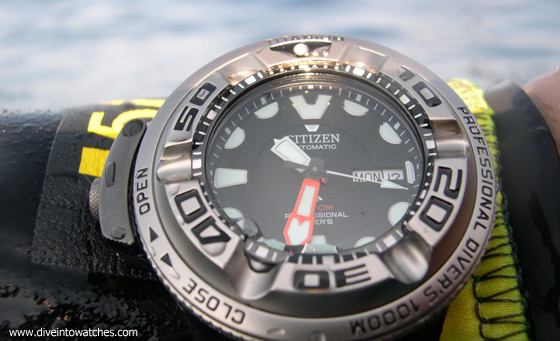
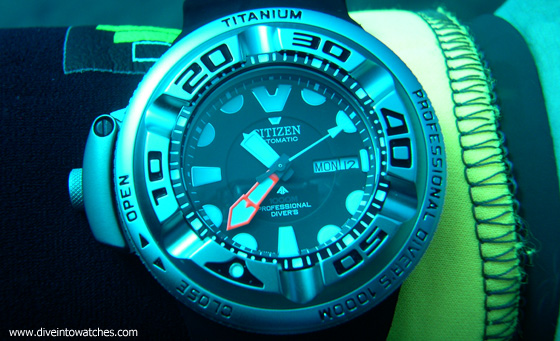
2. Internal bezel
Most likely introduced by Aquastar in the 1960s. In this construction, the bezel is located inside the watch and is thus protected by the crystal, giving the watch a more elegant look. The bezel can only be operated with a (usually additional) crown, quite often in both directions (exceptions include the Audemars Piguet Royal Oak Offshore Diver, Hublot Oceanographic, etc.). Disadvantage: An additional opening in the case (except maybe for the first Aquastar models, and the recent Maurice Lacroix Pontos S, in which the chronograph pusher also operates the bezel) and often a rather small crown to fumble with. The more secure it is designed (unidirectional, screw-in), the less practical it becomes for diving.

In 2002, Eterna introduced, with its KonTiki Diver, an interesting first fusion of both concepts: the internal bezel could be operated from the outside, a concept that first allowed a water resistance of 200 meters and, in 2005, up to 1,000 meters with the more radical-looking Concept Diver.
In 2014, IWC went all the way and seems now to be offering, for the first time, the best of both worlds: The current IWC Aquatimer family features a system, called Safedive, that combines a unidirectional internal bezel that can only be rotated with a ratcheting external bezel (which can be moved in both directions, but only counter-clockwise for adjusting the internal bezel). The IWC video below demonstrates how it works:
So, after more than 60 years of dive watches, this may be the ring that rules them all…


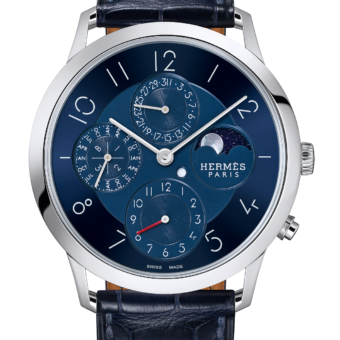


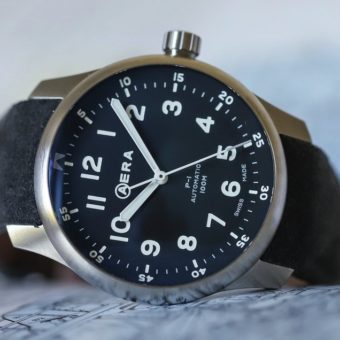

Out of curiosity, has anyone made a bezel with “combination” markings to permit using it as either a compass tool OR a countdown (or countup) timer tool?
Good morning, please what is the small dial face
That has 30 40 20 with a red hand within the main dial face?
I ask the purpose of the numerical bezel on a watch. When I saw the answer, I wanted to slap my forehead and say, “Duhhhhh.” It made perfect sense and I learned something about needed the bezel is on dive watches. Thank you, Sister T
I always thought it was a compass-like tool. Now I know.
Certified diver. I use a dive computer and my Seiko as a backup. I love my Seiko and it’s my ‘go to.’ I will not dive with my luxury diver as I don’t want it submerged in salt water. The salt can cause a bezel to drag and I’ve already had my Seiko cleaned a few times. In any event, the dive watch is a backup for most divers. We rely heavily on computers. Most dive masters actually have two dive computers (one for back up), and a dive watch.
Established use of bevel requires the diver to remember the dive time in minutes read from the o on bevel. It is much easier to set the o on the bevel at the required time in minutes for the dive, then one can see quite clEarly the time elapsed without having to remember the dive time. Works for me all the time
Rotating bezels are also useful for pilot navigation, allowing charts to be marked up in “minutes flown along track”, or ETE (estimated time en-route) in the planning stage rather than actual “clock time”, or ETA (estimated time of arrival), you intend to be overhead a point. Very useful if you don’t know the time, or think you might miss a specific time to set coarse.
Simply rotating the 60 minute mark on the bezel to the minute hand position when you set coarse allows you to read your ETA for ATC directly off the watch next to your ETE along track on the bezel. Unfortunately, for some reason, most fashion watches, and divers watches for that matter, are not marked clearly enough, except for the first 15 minutes of rotating bezel, to be of any use !
Clear skies,
Nigel B
That’s an interesting array of watches lined up and I understood the use of the bezel.
Nice article.
At the price point I can afford (almost) the simple Seiko Divers is boss. One way ratcheting bezel, large minute hand, bright illumination, screw down crown. Since my first Seiko Divers in 1970 they just keep getting better. I found your article very informative and will save it. Surfed but never dove. Expensive and my fear of the unknown in that environment. Divers all have balls in my book. Especially the guys who were issued the Rolex Comex. Ciao
Is there a watch that the bezel rotates both ways?
DD
Vostok Amphibian.
It seems to primarily be recreational divers who discount the use of dive watches. I’m a diver too and use a dive watch as a redundant bottom timer and to tell the time (fancy that).
Computers are great but they fail. Many technical divers are bemused at how confident recreational divers are in their dive computers. The user manual in my current computer tells you never to trust it and to always have a redundancy for when (not if) it fails. I agree, I having had several failures over the years – both in computer hardware and software.
To pick on a point in the article. Dives aren’t limited to 30-50 mins at all and the design of bezels has nothing to do with any such time limit. Commercial charters often limit recreational dives to 50bar/50mins but that is just for matters of practicality running the boat.
As you can see from the comments above, divers don’t use these watches to dive. But I find so many uses for rotating bezels, that I won’t buy a watch without one. I time medications, barbecues, lectures, etc. I strongly prefer bidirectional and even modify some to achieve that. I also prefer 12 hour scales for their cleaner look.
i am a certified diver. I use a computer. I leave my Seiko dive watch ( that i love ) at the hotel.
Most divers use dive computers…if watch is used, it is for back up.
Any insight on what type of spring a Doxa dive watch uses? It seems to be unidirectional but recently mine started moving both directions.
I use the bezel on a diving watch to keep golf score-one click = 1 hit. Very handy.
Even though most professional divers today rely on watches especially designed for diving only, I like when I see a say old school diving watches ( like these two ) of the article that pay attention to the basics:- GOOD VISIBILITY and RELIABLE BEZEL to mark the time. on the opposite side, take for instance the Mare Nostrum from Panerai. The ahestetics came above functionality and the very thin hands are hard to see, depending on the conditions of the sea one is scuba diving.
Most divers use dive computers…if watch is used, it is for back up.
You have forgotten Doxa Sub 300 with unidirectional, counter-clockwise (the first or among the first) rotating bezel in 1967.
The first Rolex with a rotating bezel was the Centregraph, introduced in 1938.